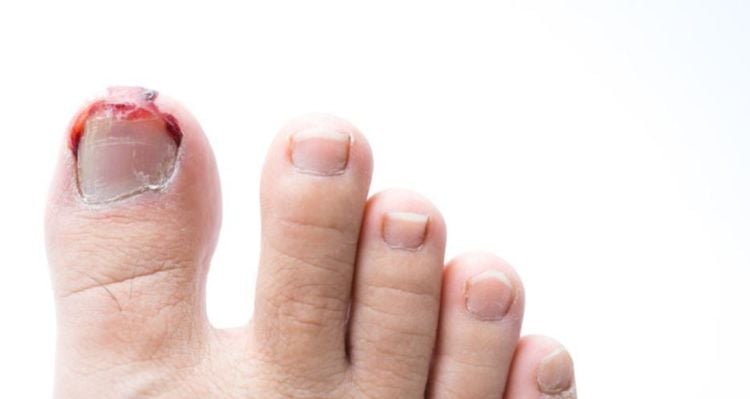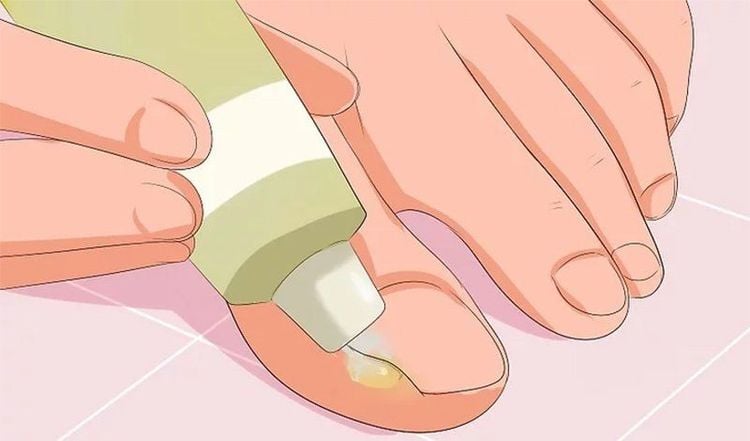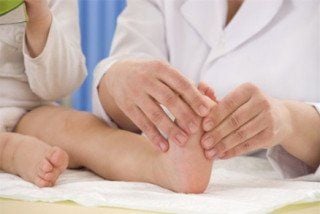This is an automatically translated article.
Painful ingrown toenail is a condition that many people face, and ingrown toenails can be treated at home. However, some severe cases require a doctor's support to avoid serious complications, especially in people with diabetes or other conditions that cause poor blood circulation.
1. What is an ingrown toenail?
Ingrown toenail is a common condition in which the corner or side of the toenail grows into the tender flesh. The result is pain, redness, swelling, and sometimes infection.
Usually you can take care of an ingrown toenail yourself. If an ingrown toenail is causing a lot of pain, your doctor can take steps to reduce discomfort and avoid complications. If you have diabetes or another condition that causes poor blood flow to your feet, you're more likely to develop an ingrown toenail complication.
2. Causes of Ingrown Toenails
Ingrown toenails may be more common in people who sweat a lot, such as teenagers. Older adults may also be at higher risk because toenails thicken with age.
Many things can cause an ingrown toenail, including:
Improper toenail trimming that causes the angle of the nail to grow into the skin Uneven, curved toenails Shoes that put a lot of pressure on the big toe lead to Ingrown toenails, such as socks or shoes that are too tight, narrow, or flat for your feet Toenail injuries, including bunions, dropping heavy objects on your feet, or kicking a soccer ball repeatedly Cleaning Improper footwork, eg not keeping your feet clean or dry Genetic predisposition You are more likely to develop ingrown toenails if you regularly participate in sports activities that use your feet a lot. Activities where you repeatedly kick an object or put pressure on your foot for long periods of time can damage your toenail and increase your risk of an ingrown toenail. These activities include: Ballet dance, soccer, kickboxing,...

Có nhiều nguyên nhân khác nhau khiến móng chân mọc ngược
3. Symptoms of Ingrown Toenails
Ingrown toenails can be painful and they often get worse in stages. Early signs include:
The skin next to the nail becomes soft, swollen, or hard Pain when pressing on the toe Fluid accumulates around the toe If an ingrown toenail causes your toe to become infected, the Symptoms may include:
Red, swollen skin Pain Bleeding Ingrown toenails pus Overgrowth of skin around the toes
4. Ingrown Toenail Treatment
You can treat most ingrown toenails at home. Here's how:
Soak your feet in warm water. Doing this for 15 to 20 minutes three to four times a day helps reduce swelling and relieve pain. Push the skin away from the edge of the toenail with a cotton ball soaked in olive oil Apply antibiotic ointment to the painful area and bandage the toe. Choose the right footwear: Consider wearing open-toed shoes or sandals until your toes feel better. Take pain relievers: Over-the-counter pain relievers such as acetaminophen, ibuprofen, and naproxen can help relieve toe pain.
If home remedies do not help your ingrown toenail, your doctor may recommend:
Nail lift. For a slightly ingrown nail (red and painful but not pus), your doctor may carefully lift the edge of the ingrown nail and place cotton, floss, or a splint underneath. This helps separate the nail from the outer layer of skin and helps the nail grow above the edge of the skin. At home, you will need to soak your toes and change the material daily. Partial removal of the toenail: For more serious ingrown toenails (red, painful, and pus-filled ingrown toenails), your doctor may trim or remove the ingrown toenail. Before this procedure, your doctor may temporarily numb your toe by injecting a numbing medicine into the toe. Toenail removal and ingrown toenail surgery: If you have repeated problems in the same toe, your doctor may suggest removing part of the nail along with the underlying tissue (the nail bed). This procedure can prevent that part of the nail from growing back. Your doctor will use chemicals, lasers, or other methods. Your doctor may also recommend topical or oral antibiotics, especially if the toe is infected or at risk of infection.

Người bệnh có thể bôi thuốc mỡ kháng sinh lên vùng móng chân mọc ngược
5. Prevent ingrown toenails
Cut your toenails straight horizontally. Do not bend your nail to match the shape of the front of your toe. Keep toenails to the right length. Trim your toenails so they are even with the tips of your toes. If you cut your toenails too short, pressure from the shoe on your toe can cause the nail to grow into the tissue. Wear well-fitting shoes: Shoes that put too much pressure on the toes or pinch them can cause the nail to grow into surrounding tissue, typically an ingrown toenail. If you have nerve damage in your foot, you may not be able to tell if your shoes fit properly. Be sure to buy and wear shoes that fit well, preferably from a shoe store that specializes in shoes for people with foot ailments. Wear protective footwear: If your job puts you at risk of injuring your toes, wear protective footwear, such as steel toe shoes. Check your feet: If you have diabetes, check your feet daily for signs of ingrown toenails or other foot problems, like diabetic feet. In summary, an ingrown toenail puncture is a tear of the soft tissue in the lateral hoof due to the anterior angle of the lateral margin of the nail plate, causing the nail to swell, become painful, and cause an infection. If the inflammation of the nail is severe, a nail puncture is necessary. Therefore, it is necessary to regularly monitor the child and seek medical attention immediately if the child shows signs of infection.
Vinmec International General Hospital is a prestigious address for examination and treatment with a sterile operating room system to avoid hospital infections. If you have a need for medical examination with experienced doctors at Vinmec, please make an appointment on the website to be served.
Please dial HOTLINE for more information or register for an appointment HERE. Download MyVinmec app to make appointments faster and to manage your bookings easily.









